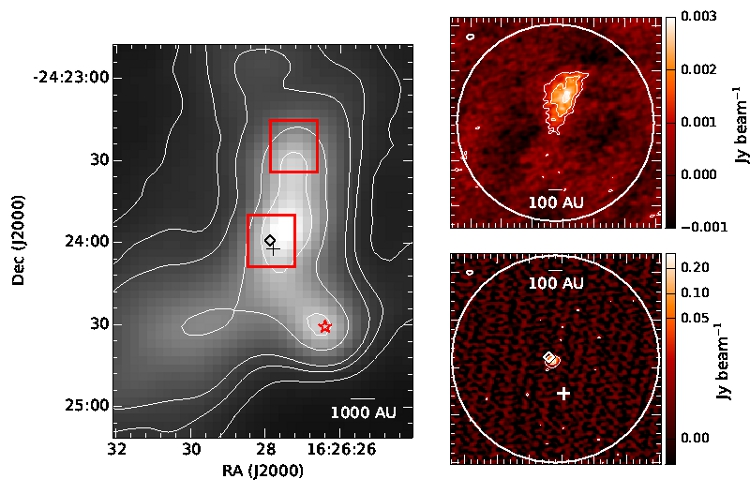| EPoS Contribution |
|
First ALMA views of H2D+ and small-scale structure toward clustered star-forming cores
Rachel Friesen Dunlap Institute, Toronto, CA | |
| The transition from prestellar core to first hydrostatic core (FHSC) or protostar, while clearly a vital step in the process of star formation, has not been well studied observationally due to the short lifetime of the FHSC stage, difficulties in establishing the relative evolutionary stage of objects, the small spatial scales involved, and the dearth of strong molecular tracers of cores at high densities. We present Atacama Large Millimeter/submillimeter Array observations of the submillimeter dust continuum and H2D+ toward two evolved, potentially protostellar cores within the Ophiuchus molecular cloud, OphA-SM1 and SM1N. The data reveal singular small-scale condensations within both cores, with effective radii ~ 40 AU and 400 AU, and maximum masses M < 0.02 MSun. We find no evidence for substructure in either source, and a Jeans analysis indicates they are unlikely to thermally fragment, suggesting both cores will form single stars. We find that SM1 is likely protostellar, and the compact condensation detected by ALMA is a warm accretion disk. We detect H2D+ only toward the more extended source, SM1N. Chemical models predict that H2D+ is likely the best kinematic probe of the dense core gas most actively forming stars, but prior to ALMA, the species had only been detected by single-dish telescopes over physical scales > 2000 AU. The less concentrated emission of SM1N suggests that it is still starless, but we observe an offset between the continuum and H2D+ that may indicate the presence of a very low luminosity source. These data reveal observationally the earliest stages of the formation of circumstellar accretion regions, and confirm that disk formation can occur very early in the star formation process, coeval with or just post the formation of a first hydrostatic core or protostar. | |
 | |
| Caption: Oph A continuum at 850 micron (JCMT; right). The cross shows the location of 6 cm radio emission detection, while the diamond shows a faint x-ray source. The Class 0 protostar VLA 1623 is identified by the star. Boxes show the zoomed in regions for SM1N (right top) and SM1 (right bottom). ALMA synthesized beams are shown in the top left corner for each source, while the large white circle shows the ~ 17.5" (FWHM) ALMA primary beam at 359 GHz. | |
| Collaborators: T. L. Bourke, SKAO P. Caselli, U Leeds, UK J. Di Francesco, NRC-Herzberg, Canada J K. Jorgensen, NBI U Copenhagen, Denmark J.E. Pineda, ETH Zurich, Switcherland |
Key publication
Suggested Sessions: Cores to Disks |

